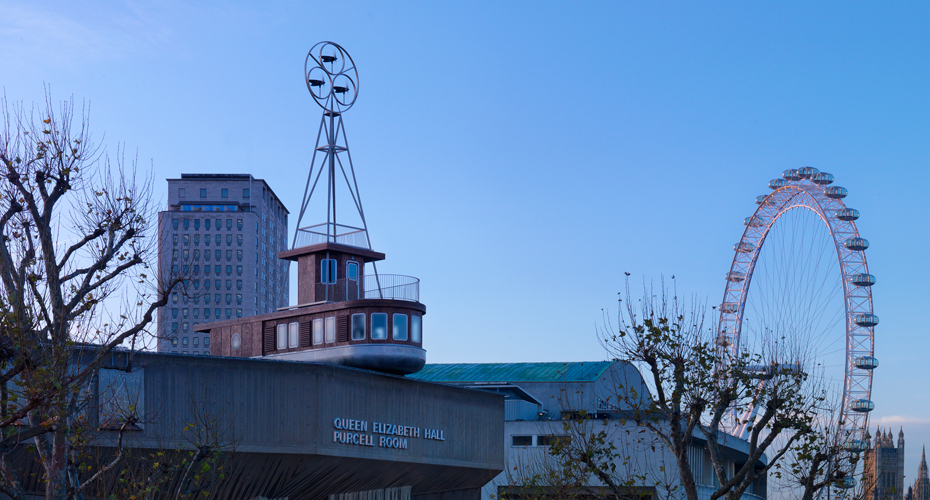With David Kohn and Fiona Banner at the helm, A Room For London steers clear of gimmickry. Edward Randell applauds a masterful piece of architectural storytelling

The boat perched on the roof, its timber bow jutting over the Thames, might have been left there by a freak tide. Or it might be new-built, ready to launch. Its presence is a paradox, a wisecrack, a problem with multiple solutions: is it an art installation, a studio space, a room for rent?
David Kohn and Fiona Banner’s design for A Room For London is, in fact, all of the above: its brilliance lies in the space it leaves for interpretation. The paddle-steamer-inspired building was announced last year as the winner of a competition organised by Artangel and Alain de Botton’s Living Architecture scheme.
The brief: to design a living space, and a place for reflection, on the roof of the Southbank Centre’s Queen Elizabeth Hall. Kohn and Banner drew on narratives of river travel, especially Joseph Conrad’s Heart of Darkness for their entry.
In a field dominated by slick, contemporary designs, it stood out as a playful, defiantly archaic addition to the Southbank’s concrete skyscape. A year later, and only a few months since construction began in earnest, the 22-tonne vessel has been crane-lifted onto the building and is ready to take on passengers.
Throughout 2012, members of the public will be able to stay overnight in the room (though it is booked up until June, and the remainder of the year is likely to sell quickly when booking reopens this Thursday). In between bookings, the room will function as a creative space. Writers including Juan Gabriel Vásquez and Jeannette Winterson, and musicians including Andrew Bird and Laurie Anderson will be invited to produce work inspired by the surroundings.
Kohn, the architect responsible for The Skyroom on the roof of the Architectural Foundation in Tooley Street, had worked with Banner before, on her ‘Harrier and Jaguar’ installation at Tate Britain. “I thought the finished project was amongst the most powerful installations I’ve ever visited,” he says.
The brief for A Room For London presented an irresistible opportunity to collaborate, and the pair soon identified Conrad as a shared inspiration. “Fiona has in the past referred to Heart of Darkness in her work,” says Kohn, “so for her I think there’s a sense of continuity in the project. I know the novel well from being very affected by it as a teenager, and so that felt like common ground. And in our work, architecturally, we’ve often promoted the idea of narrative and stories.”
“In our work, architecturally, we’ve often promoted the idea of narrative and stories.”
Sure enough, visiting the boat – named the Roi des Belges after the ship captained by Conrad – feels like a narrative experience, a miniature quest divided into chapters. First, find the hidden nook behind the QEH. Next, take the lift to the roof, whose long, slow climb (any faster and it might be heard in the concert hall) heightens the suspense. Cross the pontoon-like boardwalk to enter the ship astern, and progress through a series of spaces – bathroom, kitchen, bedroom, upper deck – each of which are subtly different in character. Kohn calls it a “Russian doll” effect: a neat mirror of the framing devices in Heart of Darkness itself.
Kohn and Banner have taken care to keep the symbolism from becoming trite or obvious. “One of the important things about it is that it’s incredibly well made,” says Kohn. “I think the only reason it’s able to sustain this level of narrative and story is that it doesn’t feel flimsy or set-like.”
Using traditional materials and craftsmanship, Kohn’s design is highly practical, making provision for stuffy summer days with ventilation slats that can be shuttered off in the colder months. Banner, meanwhile, has seeded the interior with allusions to Conrad, to London’s colonial history, to the banking crisis – all with an impressively light touch. “The hope is it’s not didactic,” Kohn says.
And at the end of the story, its grand climax: the view of London and its ancient river (with that colonial prize, Cleopatra’s Needle, dead ahead). Utterly familiar, yet reframed and somehow made new, the view says more about the Olympic city than molten-metal mascots ever could. As Conrad writes: “What greatness had not floated on the ebb of that river into the mystery of an unknown earth! . . . The dreams of men, the seed of commonwealths, the germs of empires.”
Bookings for A Room For London reopen on 19 January.




